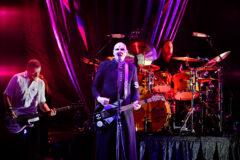JAKE SCOTT – “DISARM”
In the 1990s, Jake Scott wanted to use music videos as his way to get known for his directing talent and to get his company Black Dog Films going. At the time, he preferred videos over directing commercials, which was the route chosen by his father Ridley Scott and his uncle Tony Scott before they became film directors. Jake was approached about directing the Smashing Pumpkins’ “Disarm” shortly after the release of his video for R.E.M.’s “Everybody Hurts,” which would go on to win four MTV Video Music Awards.
Where were you in your career when you got “Disarm”?
I was doing a lot of alternative rock, and “Everybody Hurts” cemented that. In fact, it was quite hard to shake it. After five or six alternative-rock videos, I started getting frustrated. In my memory, R.E.M. was held back from release after we filmed the video because of how they wanted to build the record and how they were going to run the singles. I was in the edit for a long time finessing it, a lot longer than you normally would be on a video, like months.
You got your start with hip-hop videos, doing two early ones for Cypress Hill.
I had fled London for work, but also because I didn’t like the acid-house scene. It drove me crazy. I was very much into hip-hop, and at that time you had the whole booming West Coast thing happening, and that’s where I wanted to go. I had done a k.d. lang video [for “The Mind of Love (Where’s Your Head?)”] that was a surprise to Warner Bros. R.E.M. were already in discussions with Tarsem who had done “Losing My Religion” and I think I was sort of the outsider on [“Everybody Hurts”]. I had been trying to break into music videos for a long time, I didn’t really want to make commercials, and I desperately wanted to start my own video company, which is now Black Dog Films. Then “Disarm” came along, and it was amazing. It was great to have that 1-2-3 of R.E.M. and then Smashing Pumpkins and then Radiohead [“Fake Plastic Trees”].
Do you remember what your treatment was for “Disarm”?
Obviously, I was drawn to the idea of a child and something seen through the eyes of a child. It was either a memory or a dream. My treatments could be quite artsy-fartsy at the time and pretty pretentious, but it was sort of perfect because it was a melancholy song with a lot of rage in it. It was based on the idea of a child who couldn’t be heard or seen. It was about childhood isolation, or something like that. I had seen a photography magazine, and I cannot remember the name of the photographer, but there was one page of these photomontages. They were these slightly surreal photographs of rooftops with things montaged over the top of them. There was something sort of Eastern European about them.I spoke to Billy and he wanted to bring in some Super 8 footage of the kid, so we did that and had him running around in the garden.
We went and found this place in Echo Park where there’s this famous, historic street with these amazing old Victorian houses. We couldn’t get the crane high enough [to film the roofs], so we put one crane on top of another crane. We shot the band against green screens or blue screens and then we overlaid them. The effects were done very roughly by a company down in Hollywood on Santa Monica Boulevard. It was as good as you could do it at the time. Now I look at the video and I’m like, “Fuck me, we didn’t really match the lighting on the band to the background lighting.” But how could you? I think we even shot the band before we shot the rooftops. But it still works, it’s surrealism.
What kind of response did you get from the band once you had the final video?
I think they were pretty happy. They’re a pretty introverted group. Jimmy [Chamberlin] was the most extroverted; the others were quite quiet, I remember. But Billy is very, very, very bright and incredibly articulate. I know they liked it and it did well for them.
Afterward, did you get labels or bands coming to you saying, “We want something like ‘Disarm'”?
I don’t remember anyone referring to “Disarm” as a video they’d like to emulate, nor “Fake Plastic Trees.” The one that I would get a lot was “Everybody Hurts.” For the longest time it was hard to shake it. But “Disarm” was so specific in its aesthetic, it was really tailored to that song.





